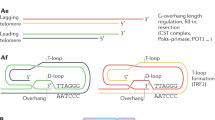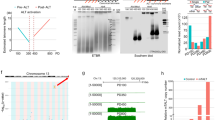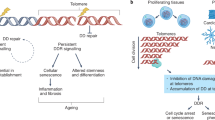Abstract
By imposing a limit on the proliferative lifespan of most somatic cells, telomere erosion represents an innate mechanism for tumor suppression1 and may contribute to age-related disease2. A detailed understanding of the pathways that link shortened telomeres to replicative senescence has been severely hindered by the inability of current methods to analyze telomere dynamics in detail. Here we describe single telomere length analysis (STELA), a PCR-based approach that accurately measures the full spectrum of telomere lengths from individual chromosomes. STELA analysis of human XpYp telomeres in fibroblasts identifies several features of telomere biology. We observe bimodal distributions of telomeres in normal fibroblasts; these distributions result from inter-allelic differences of up to 6.5 kb, indicating that unexpectedly large-scale differences in zygotic telomere length are maintained throughout development. Most telomeres shorten in a gradual fashion consistent with simple losses through end replication, and the rates of erosion are independent of allele size. Superimposed on this are occasional, more substantial changes in length, which may be the consequence of additional mutational mechanisms. Notably, some alleles show almost complete loss of TTAGGG repeats at senescence.
This is a preview of subscription content, access via your institution
Access options
Subscribe to this journal
Receive 12 print issues and online access
$209.00 per year
only $17.42 per issue
Buy this article
- Purchase on Springer Link
- Instant access to full article PDF
Prices may be subject to local taxes which are calculated during checkout





Similar content being viewed by others
References
Hahn, W.C & Weinberg, R.A. Modelling the molecular circuitry of cancer. Nat. Rev. Cancer 2, 331–341 (2002).
Kipling, D. Telomeres, replicative senescence and human ageing. Maturitas 38, 25–37 (2001).
Harley, C.B., Futcher, A.B. & Greider, C.W. Telomeres shorten during ageing of human fibroblasts. Nature 345, 458–460 (1990).
Baird, D.M., Jeffreys, A.J. & Royle, N.J. Mechanisms underlying telomere repeat turnover, revealed by hypervariable variant repeat distribution patterns in the human Xp/Yp telomere EMBO J. 14, 5433–5443 (1995).
von Zglinicki, T., Saretzki, G., Docke, W. & Lotze, C. Mild hyperoxia shortens telomeres and inhibits proliferation of fibroblasts: a model for senescence? Exp. Cell Res. 220, 186–193 (1995).
Levy, M.Z., Allsopp, R.C., Futcher, A.B., Greider, C.W. & Harley, C.B. Telomere end-replication problem and cell aging. J. Mol. Biol. 225, 951–960 (1992).
Karlseder, J., Smogorzewska, A. & de Lange, T. Senescence induced by altered telomere state, not telomere loss. Science 295, 2446–2449 (2002).
Allshire, R.C. et al. Telomeric repeat from T. thermophila cross-hybridizes with human telomeres. Nature 332, 656–659 (1988).
Lansdorp, P.M. et al. Heterogeneity in telomere length of human chromosomes. Hum. Mol. Genet. 5, 685–691 (1996).
Baird D.M., Coleman, J., Rosser, Z.H. & Royle, N.J. High levels of sequence polymorphism and linkage disequilibrium at the telomere of 12q: implications for telomere biology and human evolution. Am. J. Hum. Genet. 66, 235–250 (2000).
Coleman, J., Baird, D.M. & Royle, N.J. The plasticity of human telomeres demonstrated by a hypervariable telomere repeat array that is located on some copies of 16p and 16q. Hum. Mol. Genet. 8, 1637–1646 (1999).
Counter, C.M. et al. Telomere shortening associated with chromosome instability is arrested in immortal cells which express telomerase activity. EMBO J. 11, 1921–1929 (1992).
Bodnar, A.G. et al. Extension of life-span by introduction of telomerase into normal human cells. Science 279, 349–352 (1998).
Varley, H., Pickett, H.A., Foxon, J.L., Reddel, R.R. & Royle, N.J. Molecular characterization of inter-telomere and intra-telomere mutations in human ALT cells. Nat. Genet. 30, 301–305 (2002).
Rubelj, I. & Vondracek, Z. Stochastic mechanism of cellular aging-abrupt telomere shortening as a model for stochastic nature of cellular aging. J. Theor. Biol. 197, 425–438 (1999).
Tan, Z. Telomere shortening and the population size-dependency of life span of human cell culture: further implication for two proliferation-restricting telomeres. Exp. Gerontol. 34, 831–842 (1999).
Smith, J.R. & Whitney, R.G. Intraclonal variation in proliferative potential of human diploid fibroblasts: stochastic mechanism for cellular aging. Science 207, 82–84 (1980).
van Steensel, B. & de Lange, T. Control of telomere length by the human telomeric protein TRF1. Nature 385, 740–743 (1997).
Greider, C.W. Telomere length regulation. Annu. Rev. Biochem. 65, 337–365 (1996).
Hemann, M.T., Strong, M.A., Hao, L.Y. & Greider, C.W. The shortest telomere, not average telomere length, is critical for cell viability and chromosome stability. Cell 107, 67–77 (2001).
Kipling, D. & Cooke, H.J. Hypervariable ultra-long telomeres in mice. Nature 347, 400–402 (1990).
Zijlmans, J.M. et al. Telomeres in the mouse have large inter-chromosomal variations in the number of T2AG3 repeats. Proc. Natl. Acad. Sci. USA 94, 7423–7428 (1997).
Allsopp, R.C. et al. Telomere length predicts replicative capacity of human fibroblasts. Proc. Natl. Acad. Sci. USA 89, 10114–10118 (1992).
Perls, T.T. et al. Life-long sustained mortality advantage of siblings of centenarians. Proc. Natl. Acad. Sci. USA 99, 8442–8447 (2002).
Wyllie, F.S. et al. Telomerase prevents the accelerated cell ageing of Werner syndrome fibroblasts. Nat. Genet. 24, 16–17 (2000).
McSharry, B.P., Jones, C.J., Skinner, J.W., Kipling, D. & Wilkinson, G.W. Human telomerase reverse transcriptase-immortalized MRC-5 and HCA2 human fibroblasts are fully permissive for human cytomegalovirus. J. Gen. Virol. 82, 855–63 (2001).
Jones, C.J. et al. Dissociation of telomere dynamics from telomerase activity in human thyroid cancer cells. Exp. Cell Res. 240, 333–339 (1998).
Bond, J.A. et al. Control of replicative life span in human cells: barriers to clonal expansion intermediate between M1 senescence and M2 crisis. Mol. Cell. Biol. 19, 3103–3114 (1999).
Sambrook, J., Fritsch, E.F. and Maniatis, T. Molecular Cloning: a Laboratory Manual 2nd edn (Cold Spring Harbor Laboratory Press, New York, 1989).
Acknowledgements
We thank J. Skinner and J. Bond for cell samples and members of our laboratory for input. This work was supported by the Association for International Cancer Research. D.M.B. is a Research into Ageing Fellow.
Author information
Authors and Affiliations
Corresponding author
Ethics declarations
Competing interests
The authors declare no competing financial interests.
Supplementary information
Rights and permissions
About this article
Cite this article
Baird, D., Rowson, J., Wynford-Thomas, D. et al. Extensive allelic variation and ultrashort telomeres in senescent human cells. Nat Genet 33, 203–207 (2003). https://doi.org/10.1038/ng1084
Received:
Accepted:
Published:
Issue Date:
DOI: https://doi.org/10.1038/ng1084
This article is cited by
-
CST–polymerase α-primase solves a second telomere end-replication problem
Nature (2024)
-
Methods that shaped telomerase research
Biogerontology (2024)
-
Genetics of human telomere biology disorders
Nature Reviews Genetics (2023)
-
Telomere Length: Implications for Atherogenesis
Current Atherosclerosis Reports (2023)
-
The importance of critically short telomere in myelodysplastic syndrome
Biomarker Research (2022)



